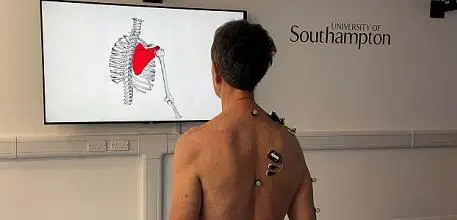World pole sport champion thanks researchers who fixed shoulder injury
For 20 years Paul Bradley, a former powerlifter, only used his ‘good’ arm to reach above his head.
An injury dislocated his shoulder and snapped the ligaments. This meant he couldn’t raise his right arm above shoulder height without considerable pain.
Now, after receiving bespoke physiotherapy as part of a study, he is the world record holder in his category for pole sport.
Rehabilitation research continues today to help patients recover from injuries, including through the NIHR Southampton Biomedical Research Centre (BRC).
Using retraining exercises
Paul took part in the Motor Control Retraining Exercises for Shoulder Impingement (MOCATS) study in 2012. This used new methods to assess shoulder blade movement and shoulder muscle function.
Peter Worsley, Professor of Assistive Technology and Tissue Health at the University of Southampton (UoS), co-led the study. It was conducted by the university’s Active Living Research Group, led by Professor Maria Stokes.
The team was able to pinpoint the cause of Paul’s shoulder impingement, where a tendon was catching on bone. From there, they identified exercises for Paul to improve his posture and teach his body to hold his shoulder in a corrected position.
“It was amazing,” said Paul. “After all those years, it started to improve within a week. It then took several months to train my body to naturally hold my shoulder in the correct position. I was so happy, and I found I could start to do more and more exercises.”
The study was supported by the Centre for Sport, Exercise and Osteoarthritis Research Versus Arthritis. A team of researchers worked with local physiotherapists to develop the intervention, including Dr Sarah Mottram, who initiated the idea for the study.

‘Transformed my life’
Shortly after starting the MOCATS trial, Paul discovered a love of pole sport after a friend invited him to try a class at Emma Simmonds’ Pole Performers Dance School in Southampton.
“I thought I was fit and strong – but it was such a tough workout that I ached for nine days afterwards,” he recalls. “I couldn’t accept I wasn’t strong enough for all the moves, so I saw it as a challenge and took it up as a hobby. As the physio improved my shoulder and I improved at pole, I could do harder and harder moves that I could never have dreamed of before.”
Paul is now a pole sport instructor and President of the British Pole and Aerial Sports Federation. He was previously Head of IT at Southampton’s National Oceanography Centre.
He has travelled the world to compete in pole sport competitions, representing Great Britain at three world championships. In 2022 he was the male 60+ world champion, and today he is the over 60s male world record holder.
“Paul’s experience is such a fantastic outcome of our study,” said Professor Worsley. “It’s wonderful to know that the work we did is still having a tangible impact today.”
“If I hadn’t taken part in the MOCATS trial, I would never have achieved any of this,” said Paul. “I’m so grateful – it quite literally transformed my life for the better.”
Continuing research
“This research on shoulder rehabilitation created a new understanding of the mechanisms of musculoskeletal injury, enabling the team to give personalised exercises and interventions,” explains Professor Worsley.
“We are continuing this research through the BRC, with a particular focus on promoting mobility and exercise in hospital to prevent muscle wasting.”
The group’s work now focusses on other joints, mainly the hip and knee, in different sports and occupational groups. It helps prevent injury (prehabilitation) as well as aid recovery in rehabilitation.
Professor Worsley is leading a project within the BRC’s Perioperative and Critical Care Theme, using the same concept of neuromuscular control.
This will develop personalised programmes to optimise movement, to help patients prepare for and recover from surgery effectively. The aim is to preserve muscle quality and improve outcomes for patients undergoing a range of elective procedures.
Photos credit: University of Southampton